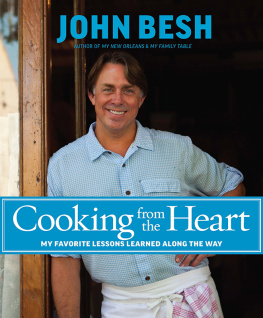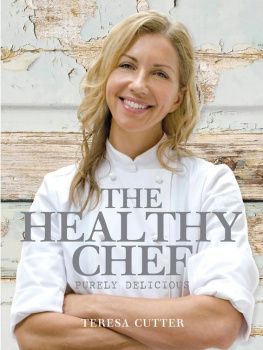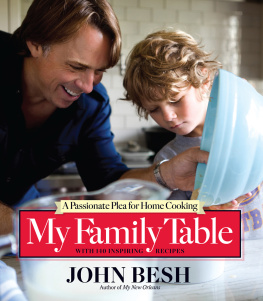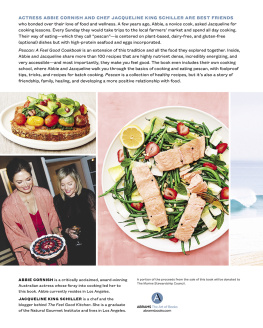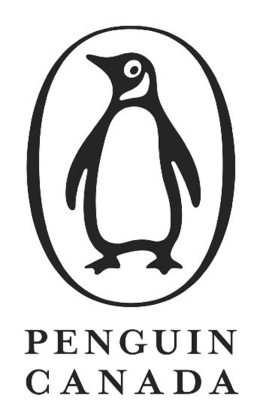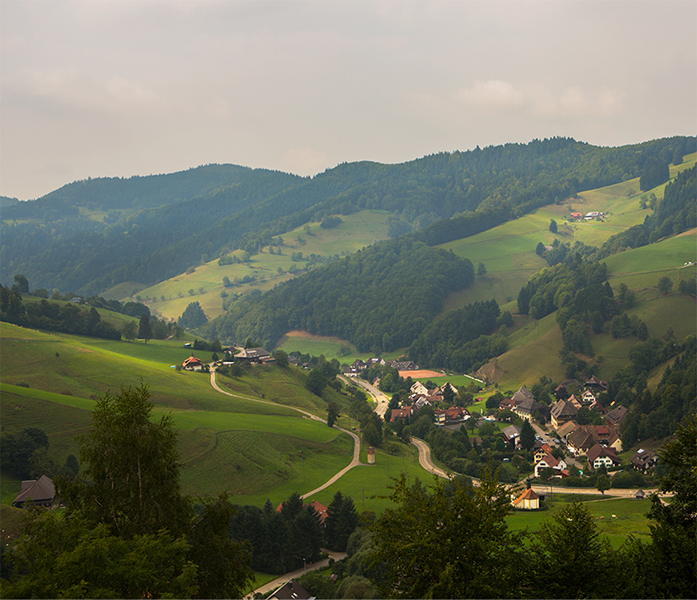ACKNOWLEDGMENTS
OUR TEAM IN PROVENCE: Me and Jenifer, Roger Sherman, Blake Aguillard, Maura McEvoy, Ariane Livaudais, Dorothy Kalins, Will Smith, and Sue Li.
Id like to recognize my wife , Jenifer, who has given so selflessly to me. She so believed in my passion for discovery that twenty years ago she put her law career on hold so that I might work for pennies, learning from talented chefs and mentors around the globe. She saw what I often didnt: This journey and its amazing life lessons would make me a better chef. And a better man.
I will forever be indebted to the Berrigan, Conzen, Fuchs, Baur, and Braud families for their delicious generosity and heartfelt hospitality over countless meals and lessons that have forever shaped my life and cooking.
Certainly there would be no book were it not for my dear Dorothy Kalins (with her gentle reminders and nudges), who produced and edited this, our third book together, and the heartfelt support of Kirsty Melville, president of Andrews McMeel. Both of them fervently believe that readers would find inspiration in Cooking from the HeartKirsty even thought up the title.
I am forever in awe of the passionate team that Dorothy brought together to make this collection of recipes and anecdotes so beautiful and so relevant: The photographer Maura McEvoy and her keen eye for the precise images to best articulate the story; Sue Li, our recipe editor, who persistently scribbled down every last step as we cooked, wrote, and tested our way through each recipe. Im so thankful for the books designer, Don Morris, and his ingenious ability to make each chapter flow to best tell my stories. Were it not for the groundwork in Europe painstakingly laid by Ariane Livaudais and her attention to every detail, we could never have accomplished so much. Thanks to our wonderful cooks, Will Smith, Blake Aguillard, and Miles Landrem, who traveled, shopped, and cooked with us. Thanks, too, to Emery Whalen and Kim Bourgault. And to filmmaker Uncle Roger Sherman. Once again, big thanks to Jean Lucas, our loyal editor at Andrews McMeel, and to our eagle-eyed copy editor, Deri Reed, who helps make my thoughts clear.
And I am thankful for my parents, Imelda and Ted Besh, from whom I inherited wanderlust, and a love of people and food that bring us together.

Lessons of the Hunt
Karl-Josef and his pals take a break at a favorite hunting spot, joined by Zorro the dog.
R E C I P E S
THE MAGICAL MNSTER VALLEY, where the hamlet of Spielweg is nestled.
I t is a cold but beautiful grey day on the mountain slopes. I follow the old man closely, careful to step lightly into the crunchy snowpack from this first, very early snowfall, certain that the slightest squeak of my heavy leather boots will scare the Reh, the majestic roe deer we glimpse as we stalk him through the forest. Already he seems skittish after a couple hours of pursuit through the thick, dark, fairytale woods that are straight out of the Brothers Grimm. My heart is racing from the battle against Mother Gravity on the steep inclines of the Belchen, the fourth highest mountain in the German Black Forest. Those leather boots and my wool pants feel like they weigh as much as I do, but I dont mind. It seems Ive spent a lifetime preparing for this moment.
My heart is racing, my boots and pants weigh as much as I do, but I don't mind. It seems I've spent a lifetime preparing for this moment.
Mountain warfare as a Marine may have given me strength, but the desert (as in Desert Storm) never offered me such utter beauty, nor the fragrance of the pine boughs moving in the high mountain air. Nor did it allow for the sound of silence as we negotiate the rough terrain, trying to outwit and harvest this deer as he glides effortlessly through thick alder and Tannenbaum , guarded by several smaller bucks who act as sentries, ready to signal alarm.
I feel just as I did at seven or eight years old, following my father and grandfather through Louisianas low-lying cypress swamps and the jagged red clay hills planted in pine, chasing after our elusive whitetail deer. I was reared to pursue the art of hunting with bows, arrows, shotguns, and rifles. The meat my family ate during hunting season was wild. So I could have approached this day in the Black Forest as just another hunt. But as my perspiration-soaked green felt hat suggests, I am experiencing a major case of nervous anticipation, knowing that around the next corner a beautiful deer might just allow me to take a clean, ethical shot. My mind races as I run through scenarios in which my chef would hand me the rifle to take the shot. The rifle itself gives me a case of the willies; its the most gorgeous weapona piece of art meticulously engraved and hand-forged by master craftsmen, each of its two barrels a different caliber (in the classic style of a Bergstutzen, a compact mountain rifle) and fitted with the best Austrian optics money can buy. A liver- and brown-colored Tyrolean hound of no small repute with, undoubtedly, a doctorate in hunting and a pedigree to match, waltzes silently alongside the old man (who is really only 32, 10 years younger than I am now, some 20 years later!). He is my chef, Karl-Josef Fuchs, a fearsome yet kind man with huge shoulders and a commanding stature that makes me want to follow him. In other words, Im way the hell out of my league and loving every minute of it.
Out of nowhere, the Reh appears just yards from us, then bounds off. With the smoothness of a jazz musician, Karl-Josef stabs his stout hiking staff into the snow and, balancing expertly, lowers the rifle to rest on the staff, fitting the butt stock perfectly to his shoulder. Not a breath is taken. Then a gentle squeeze of the trigger releases the jarring, violent roar of the .300 Win Mag. Its energy drops the beautiful deer in its tracks, no more than 100 yards away. This is why he uses such a large cartridge, my chef explains: hunting is only ethical when one doesnt cause the animal any pain. A clean, ethical kill tastes better too; adrenaline gives the meat an undesirable musky flavor.
Without wasting time, my chef carefully removes his small, stag-horned knife from a tiny pocket on the side of his lederhosen. He slices a small branch from a fir tree and briskly approaches the felled animal, opens its mouth, and inserts the branch. Eyes closed, he quietly prays over the deer. Later, hell tell me that the evergreen will feed the soul of the animal in eternity. With such care given to every aspect of the harvest, I know that cooking it will be inspiring. But before we can do that, our Reh must be properly field dressed, the entrails removed, and the heart, liver, and kidneys cared for. These organs, Karl-Josef explains, are the prize. As for the rest of the magnificent beast, it will hang in the meat locker outside the kitchen for up to seven days.
Word of our fruitful hunt doesnt take long to get out and by the time we return home to the Spielweg (the restaurant where I am interning for a year), Coco, the local wild game inspector, is there waiting in the pristine, white-tiled kitchen, microscope in hand. I laugh to myself, imagining a USDA meat inspector showing up to take tissue samples of our wild game minutes before we serve it to paying guests! Coco does his thing and then settles in to enjoy his schnapps and listen to tales of the hunt. The usual suspects who drink nightly in our employee dining room had shown up earlier in the day; now the farmers and neighbors and fellow hunters make their way to the open window that graces the garde manger kitchen, primed for a morsel of the preparation Karl-Josef will dream up for his fresh venison liver. As they knock back juice cups of Markgrfler, the local red wine, the jovial entourage grows ever more boisterous, making me realize that such post-hunt gatherings are woven thick into the fabric of life here in this tiny mountain hamlet.

